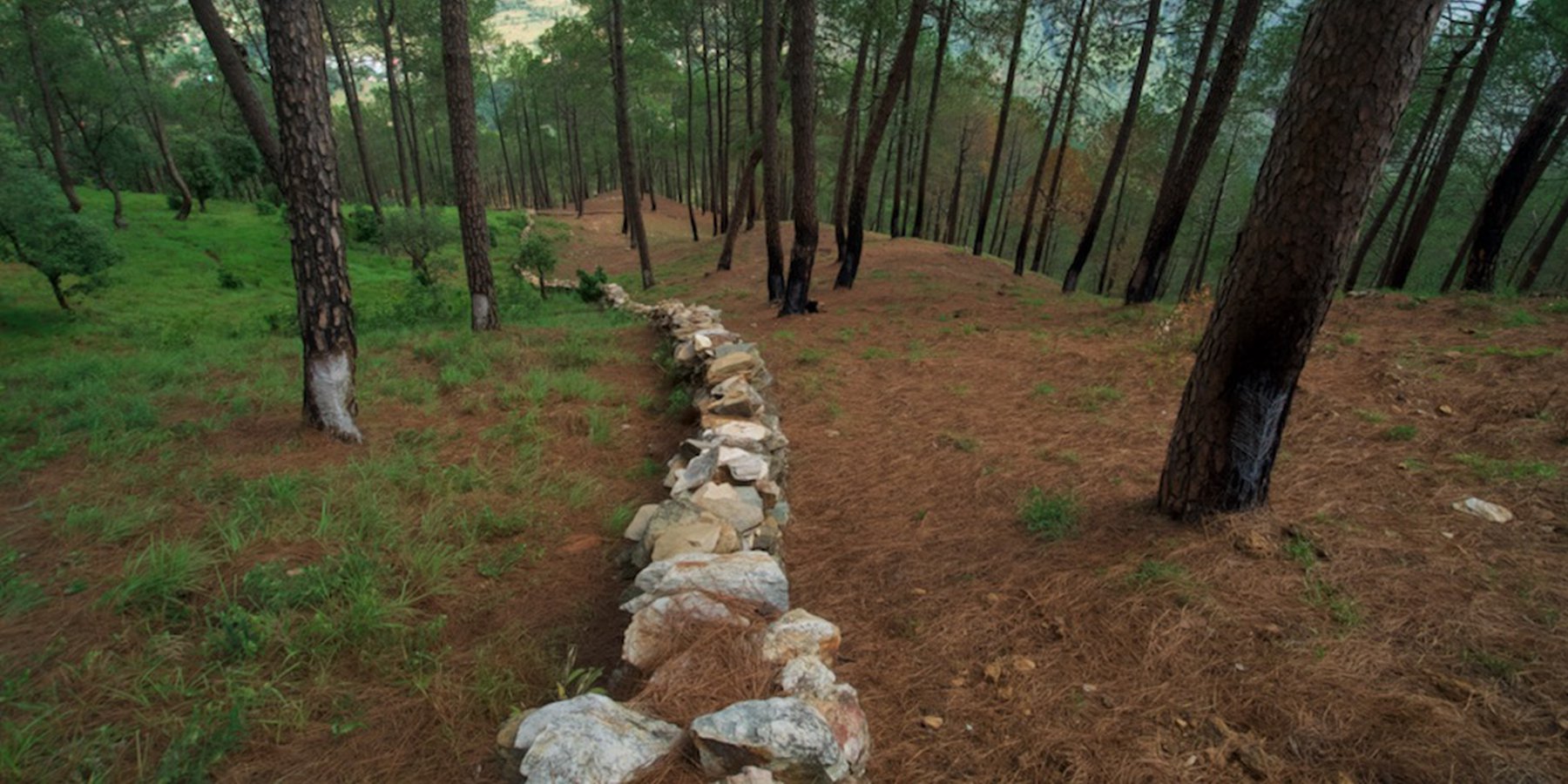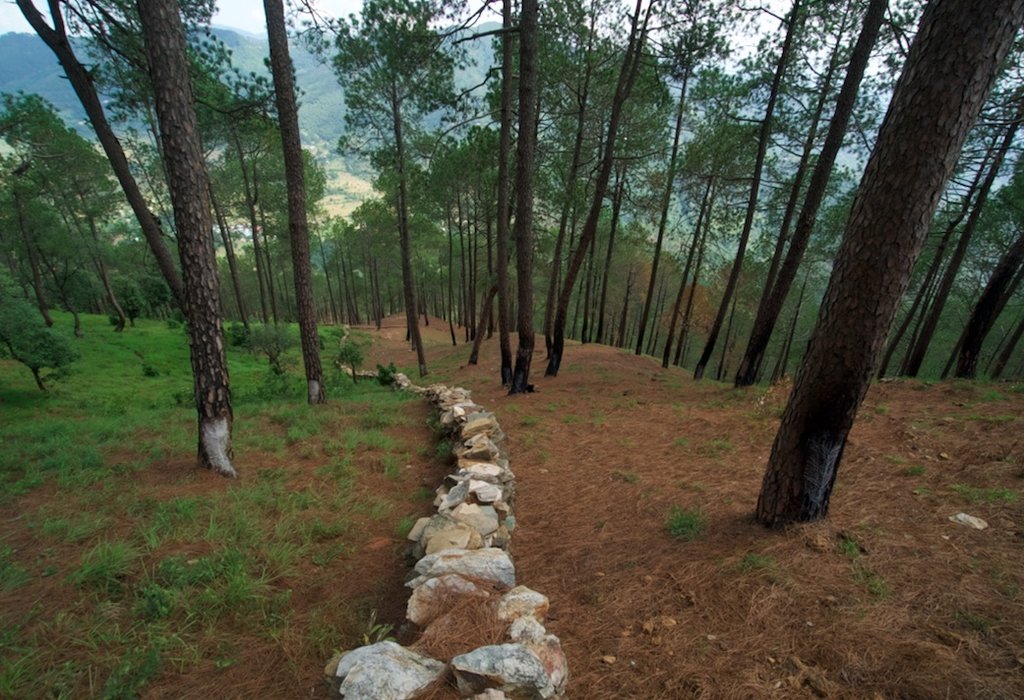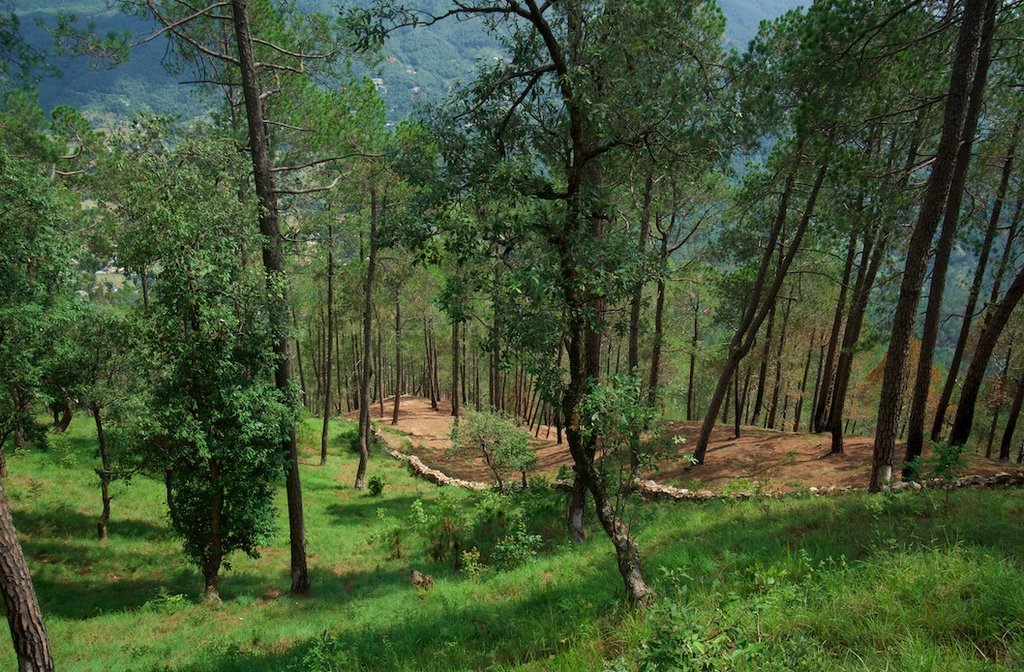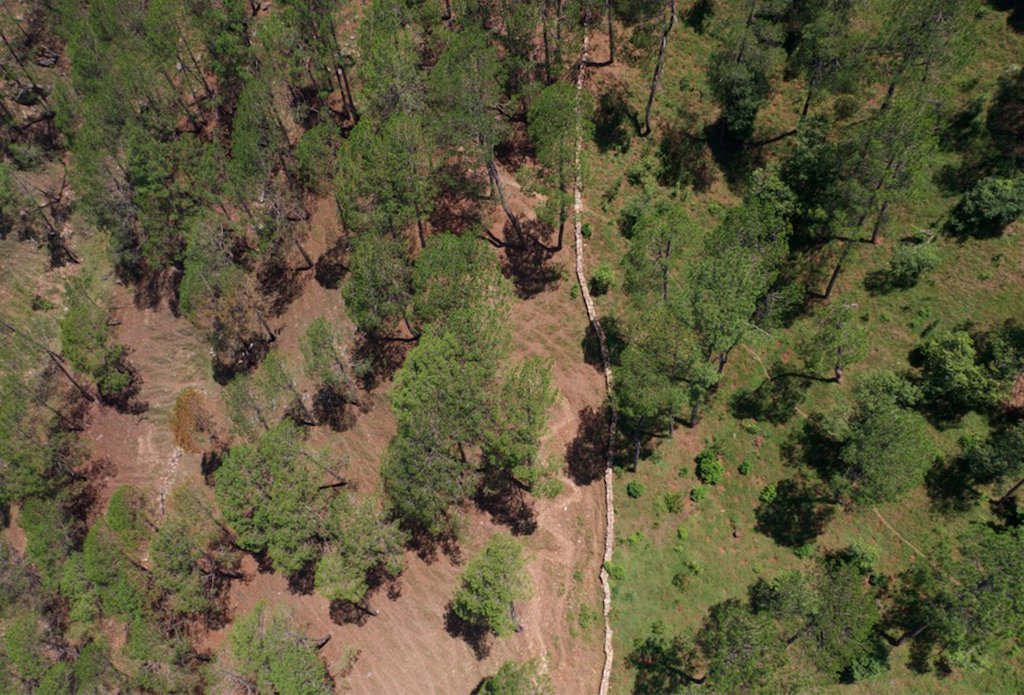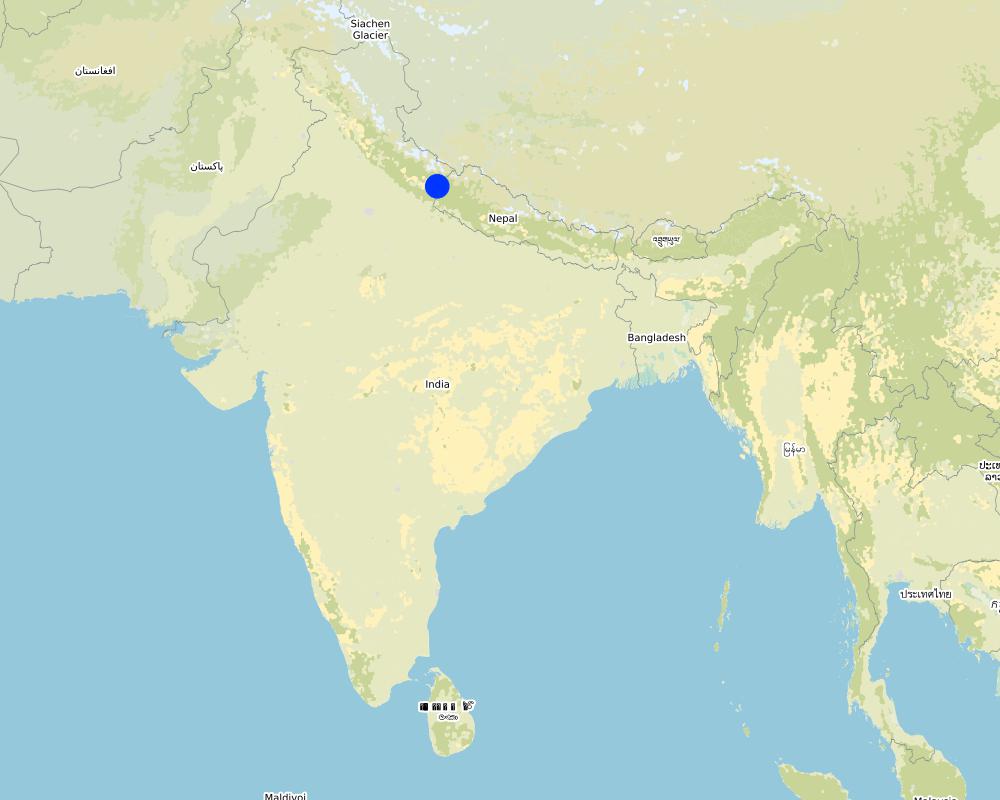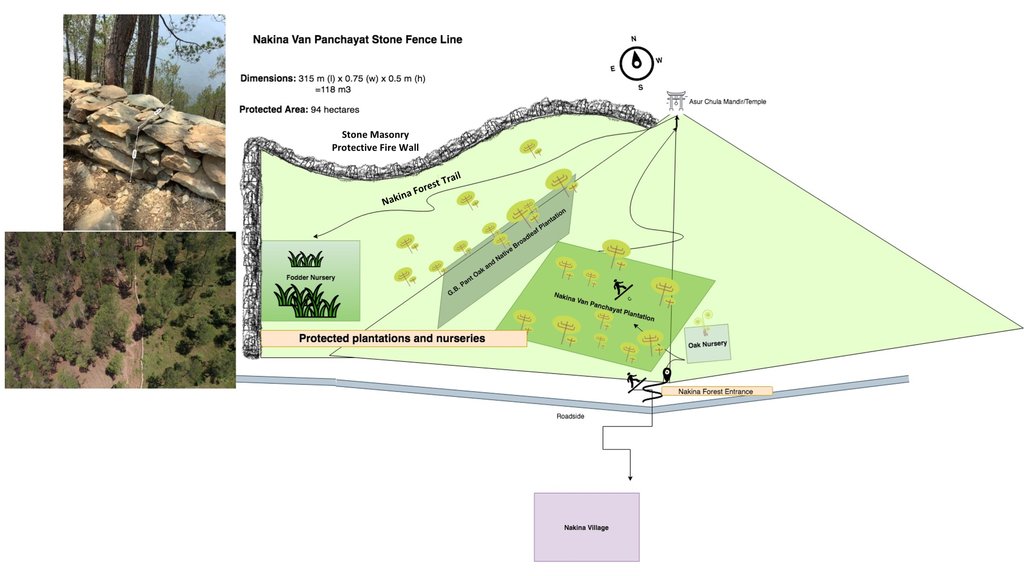Stone Wall Fencing and Firebreak for Forest Protection [Индия]
- Создание:
- Обновить:
- Составитель: Jaclyn Bandy
- Редактор: –
- Рецензент: Hanspeter Liniger
technologies_5201 - Индия
Просмотреть разделы
Развернуть все Свернуть все1. Общая информация
1.2 Контактные данные специалистов и организаций, участвующих в описании и оценке Технологии
Ответственный (-ые) специалист (-ы)
землепользователь:
Joshi Jagdamda
Sarpanch, Nakinia Van Panchayat (Forest Community Head)
Индия
Название проекта, содействовавшего документированию/оценке Технологии (если применимо)
Onsite and Offsite Benefits of SLMНазвание организации (-ий), содействовавших документированию/оценке Технологии (если применимо)
ICIMOD International Centre for Integrated Mountain Development (ICIMOD) - НепалНазвание организации (-ий), содействовавших документированию/оценке Технологии (если применимо)
G.B. Pant Institute of Himalayan Einvironment & Development (G.B. Pant Institute of Himalayan Einvironment & Development) - Индия1.3 Условия, регламентирующие использование данных, собранных ВОКАТ
Составитель и ответственный(-ые) специалист(-ы) согласны с условиями, регламентирующими использование собранных ВОКАТ данных:
Да
1.4 Декларация по устойчивости описываемой Технологии
Вызывает ли описанная здесь Технология проблемы деградации земель настолько, что ее нельзя назвать природосберегающей?
Нет
1.5 Ссылка на Анкету (ы) по Подходам УЗП (документируется с использованием ВОКАТ)
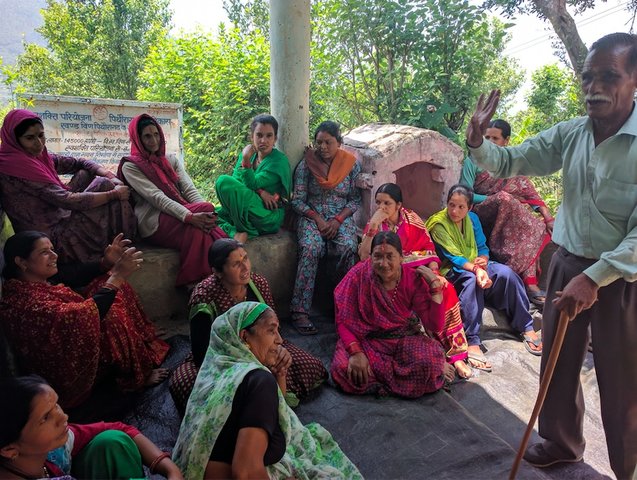
Community Forest Management in the Nakina Van Panchayat [Индия]
Van Panchayats or village forest councils are a impressive example of grassroots community management of natural resources, where a specific administrative unit is locally elected by community members who are responsible for the management of activities related to the forest.
- Составитель: Jaclyn Bandy
2. Описание Технологии УЗП
2.1 Краткое описание Технологии
Определение Технологии:
A rubble stone wall demarcates the community forest of Nakina Village and acts as a protective barrier against wildfire, wildlife, grazing, and human encroachment. The stone wall fencing is complemented by a firebreak, which is a gap of 2 meters. Firebreak establishment requires the removal of pine needles and debris from the border of the wall, so as to reduce the fuel load and possibility of fire spreading to the community forest.
2.2 Подробное описание Технологии
Описание:
1. The technology has applied in the natural environment (Nakina Van Panchayat)
2. Characteristics of the technology:-
It is a dry stone wall in the community forest.
The wall (3.15km, 1m height, 80 cm width) is 40 years old and is being regularly maintained. The community is currently extending it to 4km.
3. Purpose and function of the technology:-
To protect the forest from forest fires.
To protect the fodder grasses from grazing animals
To protect the community forest from encroachment
To make a margin between two community forests.
4. Major activities and inputs needed to establish and maintain the technology:
Obtaining funding and external support to make the stone wall from other agencies (JICA, Forest Department)
The Forest department and Nakina Van Panchayat were the implementing agencies, and received approval from the District Magistrate to build the wall.
Nakina Van Panchayat organized the community people to construct the wall, paying each person 400 INR ($5.20 USD) a day for their work.
The community pooled their own construction materials and rocks were gathered on site.
5. Benefits and impacts of the Technology:
-Helps to protect forest fires from spreading to the Nakina community forest (physical barrier)
-Protect the fodder grasses from grazing animals
-Avoid conflict between two community forests and deter outsiders from crossing the wall
6. Impacts of the technology:
The wall is successful in protecting the forest from wildfire and it inhibits wildlife/livestock movements or passage.
The people of Nakina village are restricted to a particular area to collect fodder and forest products, which helps them regulate and realize their specific resource demands. This helps them avoid overexploitation of forest resources and set limits.
People views about the technology:-
Like: People are very positive about this technology and they believe that extending its length from 3.15km to 4km will further benefit the forest.
Dislike: The aesthetic of the forest is slightly compromised due to the construction wall.
During construction period, the people realized that some noise pollution from breaking stones could have disturbed neighbors grazing their livestock or other wildlife
2.3 Фотографии, иллюстрирующие Технологию
2.5 Страна/ регион/ места, где применяется Технология, информация о которых собрана в данной Анкете
Страна:
Индия
Административная единица (Район/Область):
Uttarakhand
Более точная привязка места:
Naikina Village, Pithoragarh Bloc
Охарактеризуйте пространственное распространение Технологии :
- равномерно-однородное применение на определенной площади
Если точная область неизвестна, укажите приблизительную площадь:
- 0,1-1 км2
Технология применяется на ООПТ?
Да
Если да, укажите:
The Nakina Van Panchayat protects 94 hectares of community forest.
Map
×2.6 Сколько лет применяется данная Технология
Если год начала применения Технологии достоверно неизвестен, дайте примерную оценку:
- 10-50 лет назад
2.7 Внедрение Технологии
Укажите, как именно Технология УЗП была внедрена:
- как часть традиционной системы землепользования (более 50 лет назад)
Пояснения (тип проекта и т.д.):
The wall is about 40 years old. It is common to separate community forests through stone fencing in well-managed Van Panchayat administrations. A stonewall fence is the ideal choice in hilly areas where stones are generally available and local people are able to make it themselves.
3. Классификация Технологии УЗП
3.1 Основные цели и задачи реализации Технологии
- повышение производства
- снижение или предотвращение деградации земель, восстановление нарушенных земель
- сохранение экосистем
- защита бассейнов рек (приводораздельной части/ нижнего течения) – в сочетании с другими Технологиями
- снижение риска стихийных бедствий
3.2 Текущий(-ие) тип(-ы) землепользования на территории, где применяется Технология
Комбинированное землепользование в пределах одной и той же земельной единицы:
Да
Укажите сочетания типов землепользования (посевы / пастбища / деревья):
- Лесо-пастбищное хозяйство

Пастбищные угодья
Интенсивный выпас/ выращивание кормов:
- Стойловое содержание/ нулевой выпас
Вид животных:
- крупный рогатый скот - молочный
- козы
Используется ли комплексное земледельческо-животноводческое хозяйство?
Да
Если да, укажите:
Manure is left or manually applied to enhance nutrient cycling of the soil and support fodder and tree growth.
Продукты и услуги:
- мясо
- молоко
Виды:
крупный рогатый скот - молочный
Виды:
козы

Леса/ лесистая местность
- Лесопосадки, облесение
Лесопосадки. облесение: Укажите происхождение и состав видов:
- Монокультуры местных видов деревьев
Тип лесонасаждений, облесение:
- субтропическая сухая лесная плантация - широколиственные
- quercus leucotrichophora, quercus glauca
Являются ли указанные выше деревья лиственными или вечнозелеными?
- лиственные
Продукции и услуги:
- Древесина
- Дрова
- Выпас/ ощипывание молодых побегов и листьев
3.3 Изменилось ли использование земель в связи с внедрением Технологии?
Изменилось ли использование земель в связи с внедрением Технологии?
- Да (Пожалуйста, заполните нижеприведенные вопросы относительно использования земель до внедрения Технологии)
Комбинированное землепользование в пределах одной и той же земельной единицы:
Да
Укажите сочетания типов землепользования (посевы / пастбища / деревья):
- Лесо-пастбищное хозяйство

Пастбищные угодья
Экстенсивный выпас:
- Полукочевое скотоводство
Вид животных:
- крупный рогатый скот - молочный
- крупный рогатый скот - немолочный тягловый
- козы
Используется ли комплексное земледельческо-животноводческое хозяйство?
Да
Если да, укажите:
Manure is left or manually applied to enhance nutrient cycling of the soil and support fodder and tree growth.
Продукты и услуги:
- мясо
- молоко
Виды:
крупный рогатый скот - молочный
Виды:
козы

Леса/ лесистая местность
- Лесопосадки, облесение
Лесопосадки. облесение: Укажите происхождение и состав видов:
- Монокультуры местных видов деревьев
Тип лесонасаждений, облесение:
- субтропическая сухая лесная плантация - широколиственные
- quercus leucotrichophora, quercus glauca
Являются ли указанные выше деревья лиственными или вечнозелеными?
- лиственные
Продукции и услуги:
- Древесина
- Дрова
- Выпас/ ощипывание молодых побегов и листьев
Пояснения:
Before the Van Panchayat was established (1952), there was grazing in the forest. Additionally, before the wall was constructed (1979), there was encroachment of livestock belonging to other villagers in the Nakina forest.
3.4 Водоснабжение
Обеспеченность водой участков, где реализуется Технология :
- богарные земли
3.5 Категория УЗП, к которой относится Технология
- лесное хозяйство в естественных и измененных лесах
3.6 Мероприятия УЗП, выполняемые в рамках Технологии

инженерные мероприятия
- И6: Стенки, барьеры, заборы, изгороди

управленческие мероприятия
- У1: Смена типа землепользования
- У2: Изменение формы/ интенсивности хозяйствования
3.7 Основные проблемы деградации земель, на решение которых направлена Технология

водная эрозия почв
- ВЭп: поверхностная эрозия/смыв верхних почвенных горизонтов
- ВЭл: овражная эрозия / оврагообразование
- ВЭо: гравитационное перемещение горных пород / оползни

биологическая деградация
- Бр: сокращение растительного покрова
- Бм: утрата местообитаний
- Бк: сокращение количества биомассы
- Бп: разрушительные последствия пожаров
- Бв: потеря природного разнообразия
- Бф: утрата биологической составляющей почв
Пояснения:
Soil erosion by water: The wall supports the forest and protected, diverse understory. Thereby, it supports infiltration, decreases runoff and its corresponding damages.
3.8 Предотвращение и снижение деградации земель, или восстановление нарушенных земель
Укажите цель Технологии по отношению к деградации земель :
- предотвращение деградации земель
- снижение деградации земель
4. Технические характеристики, мероприятия по практической реализации, вложения и стоимость
4.1 Технический рисунок, иллюстрирующий Технологию
Спецификация (пояснения к техническому рисунку):
Length: 3.15 km
315 m (l) x 0.75 (w) x 0.5 m (h) = 118 m3
Firebreak: 2m of littler is cleared on each side of the wall (1x per year during the dry season, after pine needles drop in April/May)
Автор:
Jaclyn Bandy
Дата:
22/08/2019
4.2 Общая информация по необходимым вложениям и стоимости
Уточните, как рассчитывались затраты и вложения:
- на технологическую единицу
Укажите единицу:
Protective stone wall
Укажите единицы измерения (если необходимо):
3.15 km
другая/ национальная валюта (название):
INR
Если это необходимо, укажите обменный курс от доллара США к местной валюте (например, 1 доллар США = 79,9 бразильского реала): 1 доллар США =:
70,0
Укажите среднюю дневную заработную плату наемных работников:
400 INR / person
4.3 Мероприятия, необходимые для начала реализации
| Деятельность | Время (сессия) | |
|---|---|---|
| 1. | Agreement between Nakina Van Panchayat, JICA and Forest Department for project implementation | Winter |
| 2. | Wall Preparation: Site demarcation, clearing of brush, vegetation, collection of stones | Winter |
| 3. | Random rubble stones of all shapes and sizes are chiseled; inconvenient edges are chipped off | Winter |
| 4. | Stones are piled on top of one another without mortar, and laid in irregular horizontal courses. | Winter |
| 5. | Regular monitoring by administrative committee on the construction site | Year round |
| 6. | Clearing dry pine needles around the dry stone (2m on each side of the wall) annually in the dry season. | April/May |
4.4 Вложения и затраты, необходимые для начала реализации
| Опишите затраты | Единица | Количество | Затраты на единицу | Общая стоимость на единицу | % затрат, оплаченных землепользователями | |
|---|---|---|---|---|---|---|
| Оплата труда | Unskilled, semi-skilled work (community) | person/day | 4200,0 | 400,0 | 1680000,0 | 100,0 |
| Оплата труда | Skilled (technical experts, trained construction workers) | person/day | 50,0 | 2000,0 | 100000,0 | 100,0 |
| Оборудование | Pick | pieces | 15,0 | 300,0 | 4500,0 | 100,0 |
| Оборудование | shovel | pieces | 20,0 | 500,0 | 10000,0 | 100,0 |
| Оборудование | pharuwa (hoe) | pieces | 15,0 | 300,0 | 4500,0 | 100,0 |
| Оборудование | khanti (digging bar) | pieces | 10,0 | 1500,0 | 15000,0 | 100,0 |
| Оборудование | hammer (5kg) | pieces | 10,0 | 2000,0 | 20000,0 | 100,0 |
| Оборудование | chino (chisel) | pieces | 10,0 | 500,0 | 5000,0 | 100,0 |
| Оборудование | Khukuri (knife) | pieces | 10,0 | 250,0 | 2500,0 | 100,0 |
| Оборудование | Small hammer (0.5-1kg) | pieces | 15,0 | 300,0 | 4500,0 | 100,0 |
| Общая стоимость запуска Технологии | 1846000,0 | |||||
| Общие затраты на создание Технологии в долларах США | 26371,43 | |||||
Пояснения:
Calculation for Labor: 0.75m/person/day
Hired Labor/Day: 30 people
Total Wall Construction/Day: 22.5m/day
Time: 3.15 km (3,150m) / 22.5 = 140 days (~ 5month)
Unit = 4200 (140x 30 people)
4.5 Поддержание/ текущее обслуживание
| Деятельность | Сроки/ повторяемость проведения | |
|---|---|---|
| 1. | Maintaining small damages to wall structure | Year-round |
| 2. | Emergency tending to large sites of damage | Monsoon |
| 3. | Frequent visitations during the dry season/fire season | Pre monsoon |
| 4. | Firebreak establishment: clearing of pine needs 2m on each side of the wall | Peak Dry season |
Пояснения:
The local people establish a firebreak (2m pine needle/brush clearance) from both sides of the wall. The labor cost is taken up by the community, which is a voluntary action.
4.6 Стоимость поддержания/ текущего обслуживания ( в год)
| Опишите затраты | Единица | Количество | Затраты на единицу | Общая стоимость на единицу | % затрат, оплаченных землепользователями | |
|---|---|---|---|---|---|---|
| Оплата труда | Unskilled/semiskilled | person-days | 100,0 | 400,0 | 40000,0 | 100,0 |
| Оплата труда | Skilled | person-days | 10,0 | 2000,0 | 20000,0 | 100,0 |
| Оборудование | Picks | pieces | 10,0 | 300,0 | 3000,0 | 100,0 |
| Оборудование | Shovel | pieces | 10,0 | 500,0 | 5000,0 | 100,0 |
| Оборудование | pharuwa (hoe) | pieces | 7,0 | 300,0 | 2100,0 | 100,0 |
| Оборудование | khanti (digging bar) | pieces | 7,0 | 1500,0 | 10500,0 | 100,0 |
| Оборудование | hammer | pieces | 5,0 | 2000,0 | 10000,0 | 100,0 |
| Оборудование | chino (chisel) | pieces | 9,0 | 500,0 | 4500,0 | 100,0 |
| Оборудование | khukuri (knife) | pieces | 5,0 | 250,0 | 1250,0 | 100,0 |
| Оборудование | small hammer | pieces | 15,0 | 300,0 | 4500,0 | 100,0 |
| Общая стоимость поддержания Технологии | 100850,0 | |||||
| Общие затраты на поддержание Технологии в долларах США | 1440,71 | |||||
Если землепользователем оплачено менее 100% затрат, укажите, кем покрывались остальные затраты:
Uttarakhand Forest Department, JICA
Пояснения:
The costs of extending the wall to 4km are included in the maintenance costs. "Unskilled laborers" or villagers are payed by the communal funds contributed to the Nakina Van Panchayat.
There is however some remaining financial support from JICA/Uttarakhand Forest Department to maintain the wall (e.g. money to cover the replacement of broken or stolen tools) and technical engineer who comes for periodic checks on the construction progress.
For the current wall extension, the land users are paid by the funds and colletive savings managed by the Nakina Van Panchayat.
4.7 Наиболее значимые факторы, влияющие на стоимость затрат
Опишите наиболее значимые факторы, влияющие на стоимость затрат:
Labor availability, extent of structural damage to the wall
5. Природные и социально-экономические условия
5.1 Климат
Среднегодовое количество осадков
- < 250 мм
- 251-500 мм
- 501-750 мм
- 751-1000 мм
- 1001-1500 мм
- 1501-2000 мм
- 2001-3000 мм
- 3001-4000 мм
- > 4000 мм
Укажите среднегодовое количество осадков (если известно), мм:
1500,00
Пояснения/ комментарии по осадкам:
Monsoon- mid-June to mid-September; July and August are the rainiest months and the temperature is warm and moist; between 70-85% of the annual precipitation occurs in the monsoon season
Укажите название соответствующей метеостанции:
India Meteorological Department, Meteorological Centre Dehradun
Агроклиматическая зона
- Умеренно-влажная
The overall climatic condition in the Pithoragarh district is governed by the southwest monsoon. It has a sub-tropical to temperate climate, with three pronounced seasons; summer, winter, and monsoon. The hilly terrain of the Himalayan region has snow cover and is cold during winter with snowfall normally occurring during the months of December to March.
Temperature- The temperature ranges from 0°C to 10°C in winter and from 8°C to 33°C in summer season. However, there is no meteorological observatory in the district. The account of the climate is based mainly on the records of the observations in the neighboring districts where similar meteorological conditions prevail. Variations in temperature are considerable from place to place and depend upon elevation as well as aspect. As the insolation is intense at high altitudes, in summer temperatures are considerably higher in the open than in the shade.
5.2 Рельеф
Склоны (преобладающие):
- пологие (0-2%)
- покатые (3-5%)
- покато-крутые (6-10%)
- крутые (11-15%)
- очень крутые (16-30%)
- чрезвычайно крутые (31-60%)
- обрывистые (>60%)
Формы рельефа:
- плато/ равнины
- гребни хребтов/холмов
- склоны гор
- склоны холмов
- подножья
- днища долин
Зона высотной поясности:
- 0-100 м над уровнем моря
- 101-500 м н.у.м.
- 501-1000 м н.у.м.
- 1001-1500 м н.у.м.
- 1501-2000 м н.у.м.
- 2001-2500 м н.у.м.
- 2501-3000 м н.у.м.
- 3001-4000 м н.у.м.
- > 4 тыс. м н.у.м.
Укажите, приурочено ли применение Технологии к специфическим условиям:
- в ситуациях вогнутого рельефа
Комментарии и дополнительные сведения по условиям рельефа/ топографии :
Average Altitude of evaluated sites: 1990m
Average Slope: 28%
5.3 Почвы
Средняя мощность почв:
- поверхностные (0-20 см)
- неглубокие (21-50 см)
- умеренно глубокие (51-80 см)
- глубокие (81-120 см)
- очень глубокие (> 120 см)
Гранулометрический состав (верхнего горизонта):
- грубый крупнозернистый/ лёгкий (песчаный)
- средние фракции (суглинистый, супесчаный)
Гранулометрический состав (на глубине более 20 см):
- средние фракции (суглинистый, супесчаный)
Содержание органического вещества в верхнем горизонте:
- среднее (1-3%)
- низкое (< 1%)
Если возможно, приложите полное описание почв или укажите доступную информацию, например тип почв, рH/ кислотность почв, ёмкость катионного обмена, содержание азота, содержание солей и т.д.
Mountain/hill soils are a collective name given to various types of soils found under the following conditions :
-under sub-tropical, temperate and sub-alpine conditions
-under various forest types
Characteristics: very thin, fertile, and may be less than a centimeter deep on steep slopes; they are mixed with pebbles, shingles (a mass of small rounded pebbles), and gravels; they have a low-medium water holding capacity. Angular and subangular fragments of parent rock may be found mixed with the lower layers of the mountain and hill soils.
Texture: varies from loamy to sandy loam.
Soil Reaction: ranges from acidic to neutral (pH 4.6 to 6.5)
Organic Matter content: 1-5%
Ferrugenous red roils are found in this district and are well developed over Himalayan rocks (quartzite, biotite schist, amphibolite schist). They are free of carbonates and deficient in nitrogen, humus and phosphorus, light textured, porous, and friable (brittle/crumbly). The soil depth ranges from about 10cm-75 cm. These soils may be grouped into two on basis of morphology
1. Red earths- loose, friable topsoil rich in secondary concretions (hard, compact mass of matter formed by the precipitation of mineral cement within the spaces between particles, and is found in sedimentary rock or soil)
2. Red loam- argillaceous soils having a blocky structure (argillaceous minerals may appear silvery upon optical reflection and are minerals containing substantial amounts of clay-like components, e.g. argillaceous limestones are limestones consisting predominantly of calcium carbonate, but including 10-40% of clay minerals)
Brown soil: is found particularly under dense broadleaved temperate and sub-alpine forests. There occurs a thick layer of humus on the forest floor (made of decomposed leaves, branches, twigs) and the topsoil is extremely rich in humus
Podsolic Soil: soil that has developed in humid/temperate conditions usually under coniferous forests (e.g. deodar, blue pine, fir, spruce) over quartzite, granites, schists and gneiss.
5.4 Доступность и качество воды
Уровень грунтовых вод:
5-50 м
Доступность поверхностных вод:
средняя
Качество воды (без обработки):
питьевая вода хорошего качества
Качество воды относится к:
грунтовые воды
Является ли солёность воды проблемой?
Нет
Происходят ли периодические затопления территории?
Нет
Комментарии и дополнительная информация по качеству и количеству воды:
Quantity: Water crisis has been a perennial problem in both the rural and urban areas of the Pithoragarh district
There is scarcity of safe drinking water of the villages in the study area. Hand pumps are often not functioning, pipe-water schemes are unreliable and the spring discharges have reduced during the dry season. Hand-pumped water often has a high iron content and bitter taste. Poor quality of groundwater in some of the naulas is mainly due to misuse and/or disuse of the structures.
A block-district groundwater resource estimation could not be carried out as the area is hilly (with slope >20%) and in major part aquifers are small, isolated bodies, and groundwater abstraction is done mainly through hand pumps and springs with small discharges.
However, we collected some physicochemical parameters that indicate the water (sourced from springs) is of good quality:
Water Quality Parameters of Springs:
pH: 6.29-8.18
Temp: 19.0-23.5 ºC
Electrical Conductivity: 109-504 µmsiemens
Total Dissolved Solids: 75-385 ppm
Other Parameters (from springs of nearby district, Champawat)
Electrical Conductivity: 127-222 µmsiemens
pH: 7.69-8.24
Calcium: 16-36 mg/l
Magnesium: 4.9-7.3 mg/l
Bicarbonate: 61-134 mg/l
Chloride: 5.3- 8.9 mg/l
Total Hardness as CaCO3: 70-110 mg/l
Source: Government of India Ministry of Water Resources, Central Ground Water Board, 2009 Groundwater Brochure of Champawat District (2009)
5.5 Биоразнообразие
Видовое разнообразие:
- средняя
Разнообразие местообитаний:
- средняя
Комментарии и дополнительная информация по биоразнообразию:
Uttarakhand has more than 7000 species of medicinal plants and 500 species of fauna. Floral diversity contributes 31% of total floral density of India. Fauna contributes just 1.58% of the total faunal density of the country. There are 119 endemic species of flowering plants in the state that exhibited 2.35% endemism and 35 faunal endemic species. Because it lies at the juncture of India, Nepal and the Tibeten Autononmous region, there often cases of poaching and smuggling of wildlife contrabands, including bear bile, musk pods and leopard skins through the borders. Yarsa Gumba Ophiocordyceps sinensis, commonly known as Caterpillar Fungus, is also illegally traded transboundary in the region, together with various plant species. Due to anthropogenic impacts, changes is soil quality, and climatic elements, the biodiversity of our study site is not as high as in other areas of the Pithoragarh district.
Citation: Sundriyal, M. & Sharma, B. (2016). Status of Biodiversity in Central Himalaya, Applied Ecology and Environmental Sciences, 4( 2), 37-43.
5.6 Характеристика землепользователей, применяющих Технологию
Осёдлый или кочевой:
- Осёдлый
Рыночная ориентация производства:
- натуральное хозяйство (самообеспечение)
- смешанный (натуральный / коммерческий)
Доходы из других источников:
- 10-50% всех доходов
Относительный уровень достатка:
- плохой
Индивидуальное или коллективное хозяйство:
- группа/ община
Уровень механизации:
- ручной труд
Пол:
- женщины
- мужчины
Возраст землепользователей:
- молодёжь
- средний возраст
- пожилой
Укажите другие важные характеристики землепользователей:
With recent development in Pithoragarh, an influx of funds coming from outside sources has caused a decline in the importance of agriculture production, which in now marginalized, based on female labour, and mainly conducted for subsistence with little surplus to sell. High caste men do not work in cultivation at all, and male tasks such as ploughing are performed by the Scheduled Caste.
Although most women are still cultivating, their work has lost economic importance. For most families, the produce does not cover the needs of the household and surplus must be bought from the market. Many of the terraces that were formerly fruit orchards (mainly citrus) have been completely abandoned. Farming is less intensive and landholdings are small and fragmented. The main crops are wheat, millet, and pulses, but yields are low as the land is not irrigated. Less livestock (cows, goats, buffalo) is kept because of the labor involved. Very little capital is returned to farming. Crops produced for the markets in the plains are replacing traditional crops to sustain the household.
With exposure to the“Modern” lifestyle, new values have also been accepted. Two children are the norm (the ideal being one son and one daughter, but at least one son in a must). Although access to education is quite good, it does not seem to result in working careers for women.
5.7 Средняя площадь земель, используемых землепользователями с применением Технологии
- < 0,5 га
- 0,5-1 га
- 1-2 га
- 2-5 га
- 5-15 га
- 15-50 га
- 50-100 га
- 100-500 га
- 500-1000 га
- 1000-10000 га
- > 10000 га
Считается ли это мелким, средним или крупным хозяйством (по местным масштабам)?
- мелкое
5.8 Собственность на землю, права на земле- и водопользование
Землевладелец:
- общинная/ поселковая
Право землепользования:
- общинное (контролируемое)
Право водопользования:
- неограниченное (неконтролируемое)
- общинное (контролируемое)
Права на землепользование основаны на традиционной правовой системе?
Да
Поясните:
Under the Kumaun Panchayat forest rules of 1931 (amended in 1976): A Van Panchayat, (community forest council), can be formed out of non-private land within the settlement boundaries of a village. Accordingly, all villagers are members of the VP upon their approval by a Sub-Divisional Magistrate under the state Revenue Department. The members are collectively referred to as the general body, which selects the management committee members through a democratic process.
Пояснения:
5-9 elected members assume control and regulation of forest resources. They additionally raise funds and mobilize the village to protect and support sustainable land use. Presently 12,089 Van Panchayats are entrusted with the management of over 5,449.64 km2 of forests.
5.9 Доступ к базовым услугам и инфраструктуре
медицинское обслуживание:
- плохой
- средний
- хорошая
образование:
- плохой
- средний
- хорошая
технические консультации:
- плохой
- средний
- хорошая
занятость (вне хозяйства):
- плохой
- средний
- хорошая
рынки:
- плохой
- средний
- хорошая
электроснабжение:
- плохой
- средний
- хорошая
транспорт и дорожная сеть:
- плохой
- средний
- хорошая
водоснабжение и канализация:
- плохой
- средний
- хорошая
финансовые услуги:
- плохой
- средний
- хорошая
Пояснения:
The situation of infrastructure is difficult and inconsistent in the hill regions because of the terrain. The major infrastructural issues are drinking water and irrigation facilities, electricity, transportation and communication facilities and social infrastructure (housing and education). As for financial services, only the State Bank of India (SBI) is active in the hill regions where it is trying to achieve the objective of 100% financial inclusion. Some villages mentioned buying into into agricultural insurance in the past, however this was a temporary enterprise and they were never compensated after extreme climatic events that occurred and damaged over 70% of their crop.
Though infrastructure and education has generally improved over the years, institutional and marketing networks in the region aimed at supporting hill-farmers are lacking.
6. Воздействия и заключительные положения
6.1 Влияние Технологии УЗП в пределах территории ее применения
Социально-экономическое воздействие
Продуктивность
производство кормов
Количество до применения УЗП :
2 ton/hectare
Количество после применения УЗП:
10 ton/hectare
качество кормов
Комментарий/ пояснения:
More broadleaf species
производство древесины
Комментарий/ пояснения:
Fuelwood from broadleaved species is more plentiful
качество леса/ древостоя
Комментарий/ пояснения:
Less pine encroachment and fire damage, tree lopping for fodder decreased by 15%
продуктивность недревесных продуктов леса
Комментарий/ пояснения:
Resin collection has increased, pines residing in the protected forest are not damaged by the fire
площадь, используемая для производства продукции
Комментарий/ пояснения:
Rehabilitated areas that had previously been barren or overgrazed
управление землями
Комментарий/ пояснения:
Less dispute over land resources with a clear demarcation
Доступность и качество воды
доступность воды для скота
Доходы и затраты
сельскохозяйственные издержки
Комментарий/ пояснения:
Less damage to plantation and fodder grasses, improved survivability of saplings and decreased costs of supplementary fodder
экономическое неравенство
Комментарий/ пояснения:
Decreased fodder availability gap during dry season
объем работ
Комментарий/ пояснения:
Women have saved approximately 1-2 hours in fodder collection
Социальное и культурное воздействие
продовольственная безопасность/ самообеспечение
Комментарий/ пояснения:
Milk production of the livestock has increased due to improved fodder availability/quality
права на землю/воду
культурные возможности
Комментарий/ пояснения:
Improved forest quality and aesthetic of forest surrounding the temple
возможности отдыха и рекреации
местное самоуправление
знания в области УЗП/ деградации земель
Комментарий/ пояснения:
Increased attention to landscape features and execution of SLM interventions within the community and Van Panchayat
смягчение конфликтов
положение социально и экономически уязвимых групп населения
Экологическое воздействие
Водный цикл/ поверхностный сток
количество воды
Комментарий/ пояснения:
Improved infiltration and soil WHC
сбор воды/ водоудержание
поверхностный сток
уровень грунтовых/ подземных вод
испарение
Почвы
влажность почв
почвенный покров
утрата почв
аккумуляция почвенного материала (намыв, эоловая, и др.)
образование корки на поверхности почв/ запечатывание
уплотнение почв
круговорот/ восполнение питательных веществ
почвенное / подземное органическое вещество/ углерод
Биоразнообразие: растительность, животный мир
Растительный покров
биомасса/ содержание углерода в надземной биомассе
разнообразие флоры
инвазивные чужеродные виды
полезные виды
разнообразие местообитаний
Климат и снижение риска стихийных бедствий
оползни и селевые потоки
влияние засух
воздействие ураганов, проливных дождей
риск пожаров
микроклимат
6.2 Влияние Технологии за пределами территории ее применения
доступность воды
надежность и постоянство водотоков
буферная/ фильтрационная способность
Укажите оценку внешних воздействий (измерений) :
The discharge of the Bhind Naula, Hess Dhara, and Vaishnavi Naula in Nakina Village has improved with the help of this water and soil conserving technology.
6.3 Подверженность и чувствительность Технологии УЗП к постепенным изменениям климата и экстремальным погодным явлениям/ стихийным бедствиям, связанным с изменением климата (в понимании землепользователей)
Постепенное изменение климата
Постепенное изменение климата
| Сезон | увеличение или уменьшение | Насколько успешно Технология справляется с этим? | |
|---|---|---|---|
| среднегодовые температуры | увеличилось | очень хорошо | |
| другие постепенные изменения климата | Rainfall intensity | увеличилось | хорошо |
Экстремальные явления, связанные с изменением климата (стихийные бедствия)
Погодные стихийные бедствия
| Насколько успешно Технология справляется с этим? | |
|---|---|
| местные грозы | хорошо |
| местный град | умеренно |
Стихийные бедствия климатического характера
| Насколько успешно Технология справляется с этим? | |
|---|---|
| засухи | хорошо |
| лесные пожары | хорошо |
Гидрологические стихийные бедствия
| Насколько успешно Технология справляется с этим? | |
|---|---|
| паводки | умеренно |
| оползни | плохо |
Пояснения:
Although the wall is structurally sound in most sections, the impact of landslides and flash floods is often too great and significant damage results on areas were the slope is steep.
6.4 Анализ эффективности затрат
Насколько получаемый результат сопоставим с первоначальными вложениями (с точки зрения землепользователей)?
Эффективность затрат в краткосрочной перспективе:
слабо позитивное
Эффективность затрат в долгосрочной перспективе:
позитивное
Насколько получаемый результат сопоставим с текущими расходами по поддержанию технологии (с точки зрения землепользователей)?
Эффективность затрат в краткосрочной перспективе:
позитивное
Эффективность затрат в долгосрочной перспективе:
позитивное
Пояснения:
The work load is quite high for establishment and maintenance of the wall, especially when there is significant damage. Although upkeep can be demanding, the community sees the benefit of their efforts. This is especially recognized when the wall is secure from all sides and the firebreak is established before the fire season begins.
6.5 Внедрение Технологии
- 1-10%
Среди применяющих Технологию землепользователей, какова доля лиц, применяющих её по собственной инициативе, т.е. без какого-либо материального стимулирования со стороны?
- 0-10%
Пояснения:
Building an extensive wall, providing necessary tools and giving compensation for the labor adds up to be an expensive endeavor. Though the community initiative to maintain the wall can be managed by the Van Panchayat, external funding is necessary for these villages in most cases.
6.6 Адаптация
Была ли Технология УЗП изменена в недавнее время с целью адаптации к меняющимся условиям среды?
Да
Если да, укажите, по отношению к каким именно изменяющимся условиям среды произведена адаптация?
- изменения климата/ экстремальные погодные явления
Укажите, что именно изменилось в Технологии (дизайн, используемые материалы или виды растений/животных и т.д.):
The wall is being extended from 3.15 km long to 4 km. The reasoning behind this is that the community believes that it will help protect the forest at a greater scale from wildfire, as the frequency is increasing due to climate change, neglect of forest management and historical pine plantations.
6.7 Сильные стороны/ преимущества/ возможности Технологии
| Сильные стороны/ преимущества/ возможности по мнению землепользователей |
|---|
| Provides protection of the forest from forest fires and livestock grazing |
| More fuelwood and fodder is made available through this protective border |
| Because of determent from grazing and other intruders (human/wildlife), saplings and grasses are protected. This has improved the health of the forest, increased groundwater availability and improved spring recharge due to slowing surface runoff and better infiltration rates within the forest. |
| Сильные стороны/ преимущества/ возможности по мнению составителя или других ключевых специалистов |
|---|
| In agreement with the landuser |
6.8 Слабые стороны/ недостатки/ риски Технологии и пути их преодоления
| Слабые стороны/ недостатки/ риски по мнению землепользователей | Возможные пути их преодоления/снижения? |
|---|---|
| Height of the wall can be too short to act as an effective barrier for intense forest fires. | The lack of height can compromised by clearing the pine needles and creating a firebreak on both sides of the wall one additional meter. Placement of vegetation where dryer areas exist (or near grassy meadows) may also act as an effective biological barrier against the fires. |
| Parts of the wall on steep slopes often get damaged or destroyed | Avoid building the wall on steep slopes. If there are vulnerable areas, other reinforcement or alternative building technique maybe necessary. For example, building with the incline of the slope into the mountain side, so that the wall acts as more of a retaining structure. |
| Слабые стороны/ недостатки/ риски по мнению составителя или ответственных специалистов | Возможные пути их преодоления/снижения? |
|---|---|
| The stone wall's function is only as good as its construction. Some parts of the wall appear to be built in a secure, durable manner whereas other parts could be easily perturbed by pressure or vibration. | Proper training on engineering a stable wall would benefit the technology and reduce maintenance. Perhaps an external technical person could supervise wall-restoration and make periodic checks. Emphasizing the importance of diligent work on construction can be encouraged and incentivized with a higher wage (e.g. 600 INR instead of 400). |
|
Stone walls have inherent weaknesses against the lateral forces of earthquake. Poorly constructed walls having inadequate interlocking between the inside and the outside faces begin to separate, resulting in to rapid weakening of the wall. |
Assure sure that the measures required to counter these weaknesses are taken during the construction so that in the event of a potentially destructive earthquake, the structure is able to withstand its impact without suffering much damage. It is best to build in areas that have firm soil or rock underneath the topsoil. Soft soils can amplify wall movement during an earthquake. |
7. Справочные материалы и ссылки
7.1 Методы сбора/ источники информации
- выезды на места, полевые обследования
Two separate field visits, about 5 workers constructing the wall
- опросы землепользователей
Onsite interview with Mr. Jagdamba Joshi
Когда были собраны данные (на местах)?
26/06/2019
7.2 Ссылки на опубликованные материалы
Название, автор, год публикации, ISBN:
A TUTORIAL: Improving the Seismic Performance of Stone Masonry Buildings, Jitendra Bothara, Svetlana Brzevm, 2011, ISBN: 978-1-932884-48-7
Где опубликовано? Стоимость?
https://www.academia.edu/20998004/A_TUTORIAL_Improving_the_Seismic_Performance_of_Stone_Masonry_Buildings
7.3 Ссылки на соответствующую онлайн-информацию
Название/ описание:
Technical Guidelines & Information for Stone Construction In Uttarakhand
Адрес в сети Интернет:
https://www.sheltercluster.org/sites/default/files/docs/disaster_management_and_mitigation_centeruttarakhand-technical_guidelines_information_for_stone_construction_in_uttarakhand_part_i.pdf
Название/ описание:
Policy Brief: Spring Revival through Sustainable Land Management (SLM) in the Himalayan Foothills: Uttarakhand, North India. Author: Liniger HP, Bandy J, Year: 2020
Адрес в сети Интернет:
https://www.wocat.net/en/projects-and-countries/projects/onsite-and-offsite-benefits-sustainable-land-management/india
Название/ описание:
Video: SLM for Himalayan Spring Revival. Author: Liniger HP, Bandy J, Year: 2020
Адрес в сети Интернет:
https://vimeo.com/429988881
Ссылки и модули
Развернуть все Свернуть всеСсылки

Community Forest Management in the Nakina Van Panchayat [Индия]
Van Panchayats or village forest councils are a impressive example of grassroots community management of natural resources, where a specific administrative unit is locally elected by community members who are responsible for the management of activities related to the forest.
- Составитель: Jaclyn Bandy
Модули
Нет модулей


